1. Jung YH, Cho IR, Lee SE, Lee KC, Kim JG, Jeon JS, et al. Comparative analysis of clinical parameters in acute pyelonephritis. Korean J Urol. 2007; 48(1):29–34.
2. Ki M, Park T, Choi B, Foxman B. The epidemiology of acute pyelonephritis in South Korea, 1997–1999. Am J Epidemiol. 2004; 160(10):985–993. PMID:
15522855.
3. Johri N, Cooper B, Robertson W, Choong S, Rickards D, Unwin R. An update and practical guide to renal stone management. Nephron Clin Pract. 2010; 116(3):c159–71. PMID:
20606476.
4. Goldman SM. Acute and chronic urinary infection: present concepts and controversies. Urol Radiol. 1988; 10(1):17–24. PMID:
3043871.
5. Goldman SM, Fishman EK. Upper urinary tract infection: the current role of CT, ultrasound, and MRI. Semin Ultrasound CT MR. 1991; 12(4):335–360. PMID:
1892694.
6. Rabushka LS, Fishman EK, Goldman SM. Pictorial review: computed tomography of renal inflammatory disease. Urology. 1994; 44(4):473–480. PMID:
7941187.
7. Kim JS, Lee S, Lee KW, Kim JM, Kim YH, Kim ME. Relationship between uncommon computed tomography findings and clinical aspects in patients with acute pyelonephritis. Korean J Urol. 2014; 55(7):482–486. PMID:
25045448.
8. Akpinar E, Turkbey B, Eldem G, Karcaaltincaba M, Akhan O. When do we need contrast-enhanced CT in patients with vague urinary system findings on unenhanced CT? Emerg Radiol. 2009; 16(2):97–103. PMID:
18665401.
9. Mamoulakis C, Tsarouhas K, Fragkiadoulaki I, Heretis I, Wilks MF, Spandidos DA, et al. Contrast-induced nephropathy: Basic concepts, pathophysiological implications and prevention strategies. Pharmacol Ther. 2017; 180(1):99–112. PMID:
28642116.
10. Rathod SB, Kumbhar SS, Nanivadekar A, Aman K. Role of diffusion-weighted MRI in acute pyelonephritis: a prospective study. Acta Radiol. 2015; 56(2):244–249. PMID:
24443116.
11. Jang SH, Lee CS, Lee MY, Hwang WM, Yun SR. Clinical differences in acute kidney injury between unilateral acute pyelonephritis and bilateral acute pyelonephritis. Korean J Med. 2012; 82(6):696–703.
12. Warren JW, Muncie HL Jr, Hall-Craggs M. Acute pyelonephritis associated with bacteriuria during long-term catheterization: a prospective clinicopathological study. J Infect Dis. 1988; 158(6):1341–1346. PMID:
3198942.
13. The Korean Society of Infectious Diseases; The Korean Society for Chemotherapy; Korean Association of Urogenital Tract Infection and Inflammation; The Korean Society of Clinical Microbiology. Clinical guideline for the diagnosis and treatment of urinary tract infections: asymptomatic bacteriuria, uncomplicated & complicated urinary tract infections, bacterial prostatitis. Infect Chemother. 2011; 43(1):1–25.
14. Chung VY, Tai CK, Fan CW, Tang CN. Severe acute pyelonephritis: a review of clinical outcome and risk factors for mortality. Hong Kong Med J. 2014; 20(4):285–289. PMID:
24625386.
15. Lim SK, Ng FC. Acute pyelonephritis and renal abscesses in adults--correlating clinical parameters with radiological (computer tomography) severity. Ann Acad Med Singapore. 2011; 40(9):407–413. PMID:
22065034.
16. Yoo JM, Koh JS, Han CH, Lee SL, Ha US, Kang SH, et al. Diagnosing acute pyelonephritis with CT, Tc-DMSA SPECT, and Doppler ultrasound: a comparative study. Korean J Urol. 2010; 51(4):260–265. PMID:
20428429.
17. Kim SH, Kim YW, Lee HJ. Serious acute pyelonephritis: a predictive score for evaluation of deterioration of treatment based on clinical and radiologic findings using CT. Acta Radiol. 2012; 53(2):233–238. PMID:
22185707.
18. Mitterberger M, Pinggera GM, Colleselli D, Bartsch G, Strasser H, Steppan I, et al. Acute pyelonephritis: comparison of diagnosis with computed tomography and contrast-enhanced ultrasonography. BJU Int. 2008; 101(3):341–344. PMID:
17941932.
19. Paick SH, Choo GY, Baek M, Bae SR, Kim HG, Lho YS, et al. Clinical value of acute pyelonephritis grade based on computed tomography in predicting severity and course of acute pyelonephritis. J Comput Assist Tomogr. 2013; 37(3):440–442. PMID:
23674018.
20. Johansen TE. The role of imaging in urinary tract infections. World J Urol. 2004; 22(5):392–398. PMID:
15290204.
21. Shen Y, Brown MA. Renal imaging in pyelonephritis. Nephrology (Carlton). 2004; 9(1):22–25. PMID:
14996304.
22. Dalrymple NC, Casford B, Raiken DP, Elsass KD, Pagan RA. Pearls and pitfalls in the diagnosis of ureterolithiasis with unenhanced helical CT. Radiographics. 2000; 20(2):439–447. PMID:
10715342.
23. Stunell H, Buckley O, Feeney J, Geoghegan T, Browne RF, Torreggiani WC. Imaging of acute pyelonephritis in the adult. Eur Radiol. 2007; 17(7):1820–1828. PMID:
16937102.
24. Browne RF, Zwirewich C, Torreggiani WC. Imaging of urinary tract infection in the adult. Eur Radiol. 2004; 14(Suppl 3):E168–E183. PMID:
14749952.
25. Bjerklund Johansen TE. Diagnosis and imaging in urinary tract infections. Curr Opin Urol. 2002; 12(1):39–43. PMID:
11753132.
26. Scholes D, Hooton TM, Roberts PL, Gupta K, Stapleton AE, Stamm WE. Risk factors associated with acute pyelonephritis in healthy women. Ann Intern Med. 2005; 142(1):20–27. PMID:
15630106.
27. Warren JW, Abrutyn E, Hebel JR, Johnson JR, Schaeffer AJ, Stamm WE. Guidelines for antimicrobial treatment of uncomplicated acute bacterial cystitis and acute pyelonephritis in women. Clin Infect Dis. 1999; 29(4):745–758. PMID:
10589881.
28. Kim SH, Kim YW, Lee HJ. Serious acute pyelonephritis: a predictive score for evaluation of deterioration of treatment based on clinical and radiologic findings using CT. Acta Radiol. 2012; 53(2):233–238. PMID:
22185707.
29. Rollino C, Boero R, Ferro M, Anglesio A, Vaudano GP, Cametti A, et al. Acute pyelonephritis: analysis of 52 cases. Ren Fail. 2002; 24(5):601–608. PMID:
12380905.
30. Tseng CC, Wu JJ, Wang MC, Hor LI, Ko YH, Huang JJ. Host and bacterial virulence factors predisposing to emphysematous pyelonephritis. Am J Kidney Dis. 2005; 46(3):432–439. PMID:
16129204.
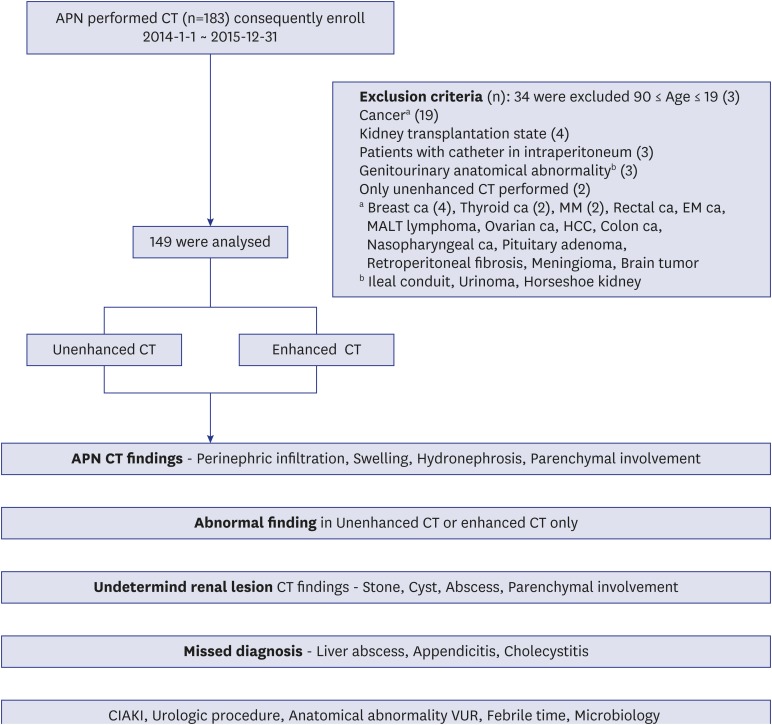
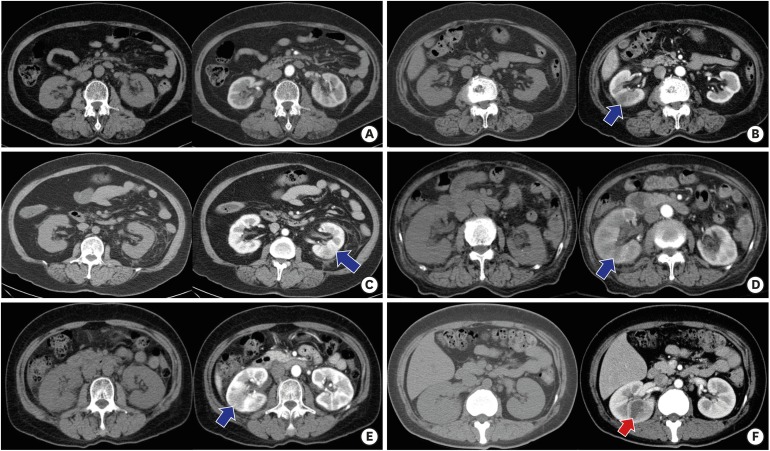

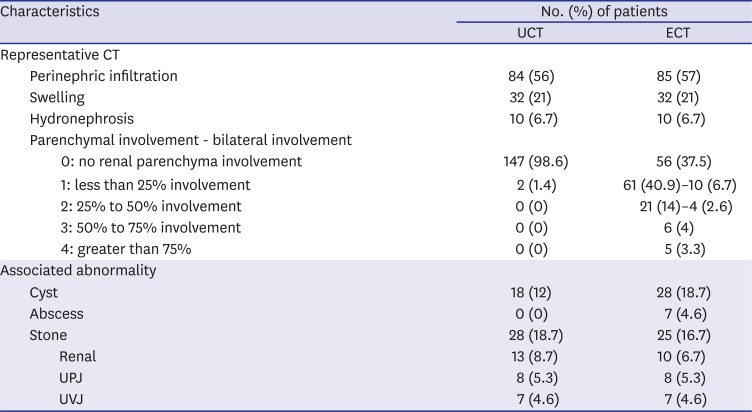

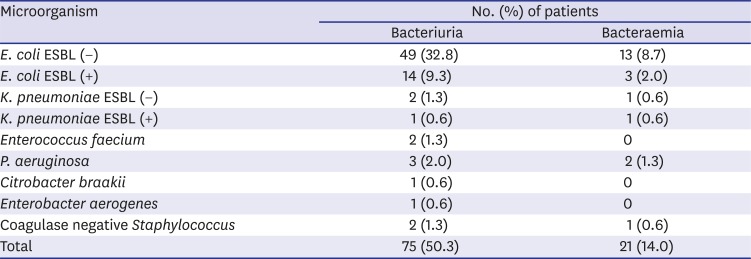




 PDF
PDF Citation
Citation Print
Print



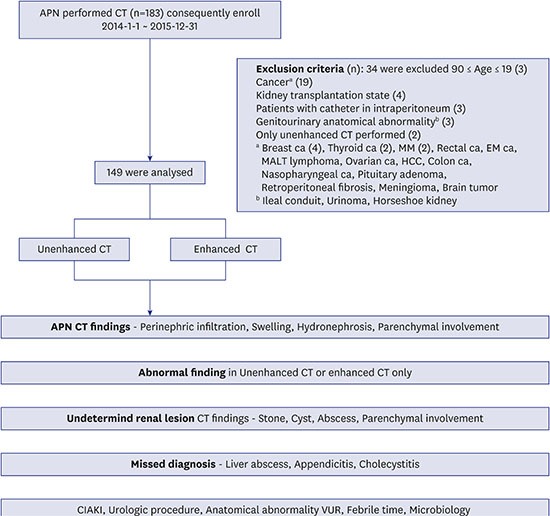
 XML Download
XML Download